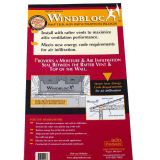
1.800.643.5596 • Lomanco, Inc. • lomanco.com
Follow us on
Twitter
Find us on
Facebook
IMPORTANT!
• Examine your roof conguration and determine the
correct amount of vents needed for proper ventilation of
your space. You can use a Lomanco ventilation guide to
determine the amount of intake vents required for your
chosen exhaust vent.
• Installation of Lomanco Roof Vents should comply with all
local codes and standards.
• WARNING! Sharp edges are exposed during installation.
Use gloves and other appropriate safety equipment to
avoid injury.
INSTALLATION:
1. Vents should be evenly spaced on the rear slope of the
roof.
2. Center the vent opening between rafters and roughly 24”
(36” Max.) down from the ridge line to keep the top of the
roof vent below the ridge line. Mark this position.
3. Using marked position as center point, scribe a circle of the
required diameter for the model vent being installed. Use
the chart below to determine the required opening size.
Model Number Opening Size (dia)
730 6¼”
750 8”
750-G 8”
750-E 8”
770 9½”
700 8”
Drill a starter hole inside the scribed lines.
4. Saw out the vent hole using the drilled starter hole.
5. Carefully remove roong nails from top row of shingles so
the ashing of the roof vent will slide under the shingles.
6. Apply roong cement around the edge of the hole.
7. Carefully slide the base of the vent under the shingles
with the embossed arrow pointing up towards the
roof’s ridge. Make sure the throat of vent is centered
over the vent hole. Fasten the base to the roof decking
with roong nails, keeping the nailheads under shingles
where possible. Seven nails are required for each vent
and should be located as shown below.
8. Finish mounting by sealing all seams and nails with
roong cement. Also use roong cement to fasten down
loose edges of shingles.
Note: On all 700 Series vents DO NOT CAULK the gap,
between the sides and base or the back and base.
Congratulations on your purchase of a 700 series roof vent. 700 series roof vents are exhaust vents that will help rid your attic of
damaging heat and moisture when properly installed and used in conjunction with proper intake vents.
NOTE: Most codes concerning residential attic ventilation require a balanced system of 50% top (exhaust) vents and 50% (intake)
vents. When this balanced system is used, Lomanco 700 series roof vents meet or exceed residential attic ventilation codes.
IMPORTANT! READ ALL INSTRUCTIONS THOROUGHLY BEFORE ATTEMPTING TO INSTALL .
22050_0613
TOP VIEW: 700 SERIES VENT
UP
Nailing Locations
700 Series Roof Vent
Installation Instructions
ITEMS NEEDED FOR INSTALLATION
• KEYHOLE SAW OR SABER SAW
• UTILITY KNIFE
• DRILL WITH ½“ BIT
• HAMMER AND ROOFING NAILS
• TAPE MEASURE
• ROOFING CEMENT
• COMPASS OR STRING
THREE
MUST
DO
Steps
to attic ventilation
Install all Exhaust Ventilation at the SAME HEIGHT within a common attic area.
Installation of exhaust vents at more than one level on a roof allows the upper exhaust vent to pull air
in from lower exhaust vents rather than from the intake vents. Intake air must come from intake vents
located near the lower part of the attic space to properly ventilate the total attic area and eliminate
weather infiltration.
Install ONLY ONE TYPE of Exhaust Ventilation within a common attic area.
Exhaust Vents pull air from the easiest intake source. Vent types cannot be mixed. The use of different
types of exhaust vents could make one of the vents act as intake for the other. Intake air must come
from intake vents located near the lower part of the attic space to properly ventilate the total attic area
and eliminate weather infiltration.
Install a BALANCED SYSTEM of Intake and Exhaust Ventilation.
50% Intake Ventilation - Intake vents located near the lower part of the attic area are required to
balance out your ventilation system.
50% Exhaust Ventilation - Use a Lomanco Ventilation Selector Guide, or the calculators at lomanco.
com to determine the number of vents needed to properly ventilate an attic to meet the Ventilation
Minimum Property Standard.
1
2
3
/




